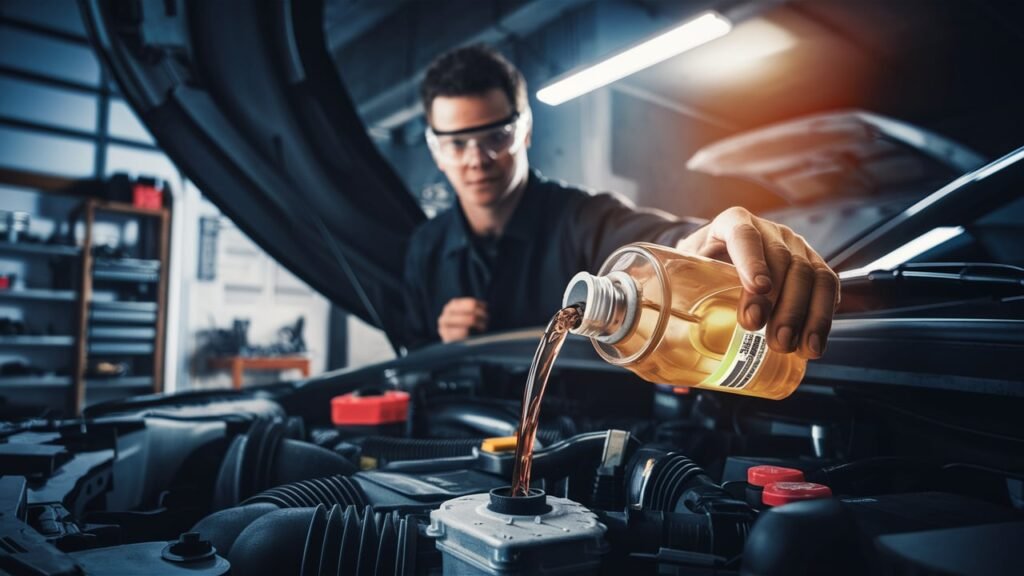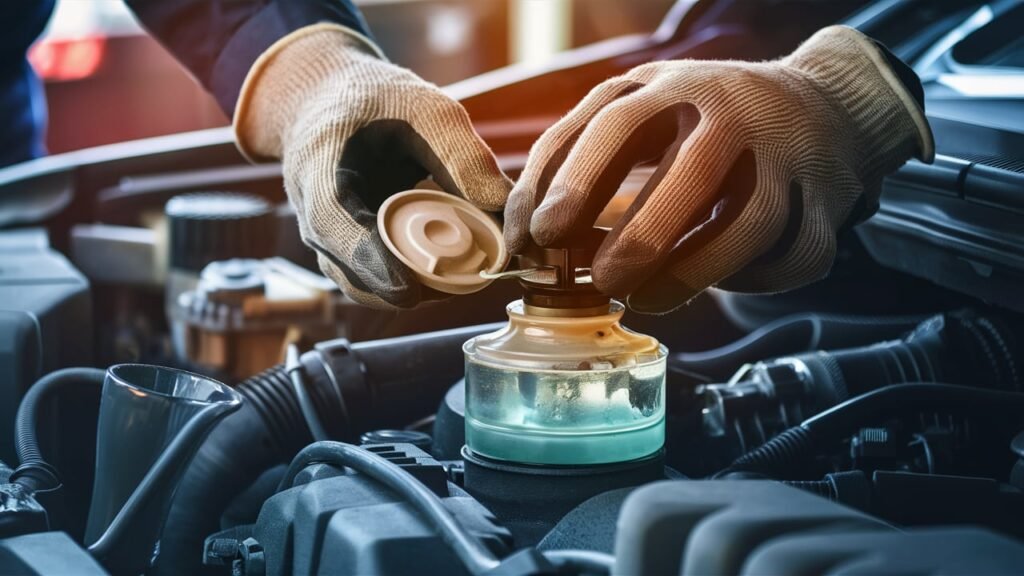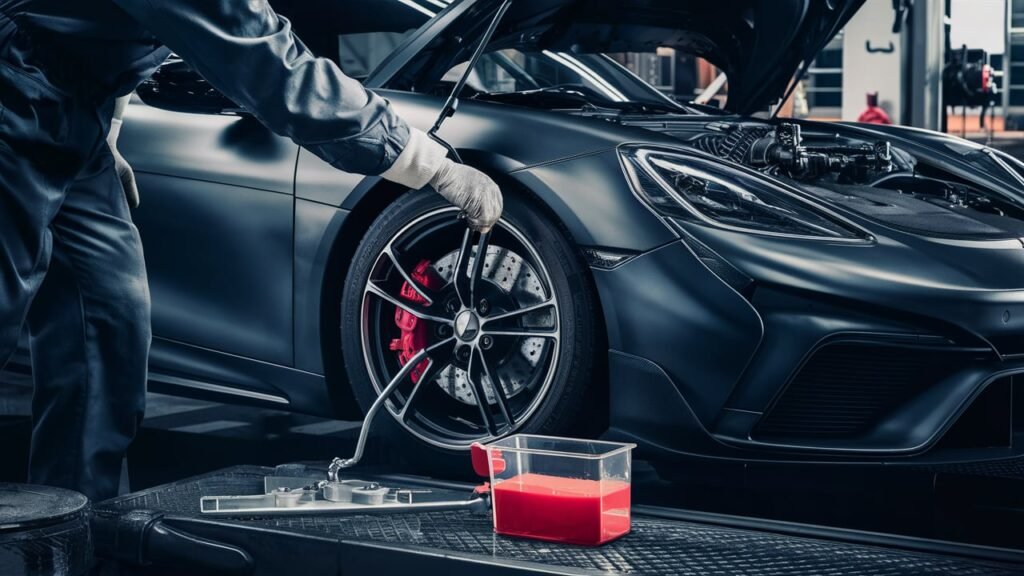
What is a car engine brake fluid refill?
In the realm of automotive maintenance, the significance of preserving the optimal performance of a car’s braking system cannot be overstated. At the core of ensuring this critical function lies the often underestimated yet essential process known as a car engine brake fluid refill.
Defined by the replenishment of hydraulic fluid that transmits force within the braking system, this routine task forms a cornerstone in maintaining vehicle safety and operational efficiency.
Embraced by car enthusiasts, DIY mechanics, and automotive technicians alike, understanding the intricacies of this procedure is paramount in upholding not just vehicular longevity but also driver security.
Within the multifaceted automotive industry, where precision reigns supreme, recurrent emphasis is placed on regular maintenance practices to uphold vehicle integrity.
As such, delving into the realm of brake fluid refills illuminates a fundamental aspect universally recognized among industry experts—attributing gravity to stable brake operation rooted in consistent fluid levels.
By unraveling this enigmatic process that involves DOT-rated brake fluids and hydraulic mechanisms, drivers are equipped with nuanced insights vital for navigating road safety challenges effectively.
Through deciphering technical nuances associated with brake fluid refills—while comprehending their implications on driving dynamics—the modern motorist arms themselves with actionable knowledge indispensable for holistic vehicular care.
Understanding Car Engine Brake Fluid.
Car engine brake fluid, often referred to as hydraulic fluid, is a specialized liquid designed to transmit force and apply pressure within the braking system of a vehicle. This essential fluid operates under high temperatures and pressures while ensuring optimal functioning of the brakes.
Composed primarily of glycol ethers or silicone-based fluids, brake fluid must maintain certain properties like a high boiling point and low compressibility to perform effectively within the braking system.
In a typical automotive setup, when you depress the brake pedal, the force is transferred through the brake lines filled with brake fluid. This pressure is then transmitted to the brake calipers or wheel cylinders, exerting force on the brake pads or shoes.

Consequently, these components clamp down on the rotors or drums, creating friction that stops the vehicle. The role of brake fluid in this process is crucial as it facilitates this hydraulic transfer of force from your foot on the pedal to stopping power at the wheels.
DOT 3, DOT 4, and DOT 5 are common types of brake fluids used in vehicles. Each classification has distinct characteristics affecting their performance under varying conditions. DOT 3 fluid is glycol-based and widely used due to its affordability and compatibility with most vehicle systems.
DOT 4 offers higher boiling points compared to DOT 3 and provides improved performance under heavy-duty applications. On the other hand, DOT 5 silicone-based fluid doesn’t absorb water like glycol-based fluids but requires specific compatibility considerations due to differences in chemical composition.
Understanding these nuances among different types of brake fluids can aid car enthusiasts and mechanics in selecting the appropriate fluid for their specific needs based on factors such as driving habits, climate conditions, and manufacturer recommendations.
By comprehending how car engine brake fluid functions within a vehicle’s braking system and discerning between various classifications like DOT 3, DOT 4, and DOT 5, individuals can make informed decisions regarding maintenance practices for optimal performance and safety on the road.
Signs That Indicate Brake Fluid Refill is Needed.
When it comes to your vehicle’s brake system, being attuned to the signs that signal a need for brake fluid refill can prevent potentially dangerous situations on the road. One of the primary symptoms of low brake fluid levels is a soft or spongy brake pedal feel.
As you depress the brake pedal, if it travels further than usual before engaging the brakes, it may indicate insufficient fluid in the braking system. This issue can compromise your ability to stop quickly in emergencies and should not be ignored.
Air bubbles within the brake lines can also disrupt brake performance. When air enters the brake lines due to low fluid levels or improper bleeding during maintenance, it can lead to a mushy brake pedal sensation.

This phenomenon, known as “brake fade,” can result in decreased stopping power and longer braking distances, posing a risk to both driver and passengers. Regularly checking for air bubbles by inspecting the clarity of the brake fluid in the reservoir is crucial for maintaining optimal braking efficiency.
Routine maintenance plays a vital role in ensuring your vehicle’s safety and performance on the road. Checking your car’s brake fluid levels regularly is essential to detect any anomalies promptly.
During routine inspections, carefully observe the color and consistency of the fluid; if it appears dark or murky, this could indicate contamination or degradation of the fluid over time, necessitating a full replacement or refill.
By incorporating these practices into your regular maintenance routine, you contribute to safer driving conditions for yourself and others on the road while extending the longevity of your vehicle’s braking system.
The Dangers of Ignoring Brake Fluid Refill.
Neglecting to refill brake fluid in a vehicle can have severe consequences that compromise both safety and performance. Insufficient brake fluid levels can lead to a drastic impact on braking efficiency.
When the fluid level gets too low, the brake pedal may feel spongy or sink closer to the floor, resulting in delayed response times during braking. This reduction in braking effectiveness is a critical safety concern as it increases the risk of accidents, especially in emergency situations where sudden stops are necessary.
Furthermore, ignoring the need for timely refills can result in potential damage to the braking system itself. Contaminated or old brake fluid loses its ability to effectively transfer force from the pedal to the brakes, leading to diminished stopping power.

Over time, moisture absorption and exposure to high temperatures can cause brake fluid to break down chemically, forming sludge and debris that can circulate through the hydraulic system. This contamination not only affects brake performance but also accelerates wear on crucial components like calipers, master cylinders, and ABS modules.
Prolonged neglect of brake fluid refill poses significant risks that extend beyond immediate safety concerns. The continued operation of a vehicle with inadequate or degraded brake fluid increases the likelihood of experiencing complete brake failure.
In extreme cases, this could result in catastrophic accidents with severe injuries or fatalities. Regularly checking and refilling brake fluid is paramount in maintaining optimal braking performance and ensuring the overall safety of both drivers and passengers on the road.
DIY vs. Professional Brake Fluid Refilling.
When it comes to refilling brake fluid in your car engine, you may have to make the choice between a do-it-yourself approach or seeking assistance from a professional technician. The DIY method typically involves locating the brake fluid reservoir, top up with the appropriate type of brake fluid following safety precautions, and bleeding the brakes if necessary.
This process can be relatively straightforward for individuals with some mechanical skills and knowledge of automotive systems. However, inaccuracies in the procedure can lead to air bubbles in the system, affecting braking performance and potentially causing safety hazards.
Advantages of performing a DIY brake fluid refill include cost savings and convenience. By taking on this task at home, car enthusiasts can save on labor costs associated with a professional service.

Moreover, for those well-versed in vehicle maintenance, DIY allows for greater control over the process and timeline of the refill. On the downside, errors during a DIY refill can result in incorrect fluid levels or improper bleeding techniques that compromise the effectiveness of the brake system. In such cases, rectifying mistakes may require additional time and resources.
On the other hand, having a professional technician handle your car engine brake fluid refill guarantees precision and expertise. Trained professionals possess specialized knowledge on different vehicle systems and types of brake fluids. They can ensure that the correct procedures are followed to maintain optimal braking efficiency post-refill.
Additionally, technicians are equipped with diagnostic tools to identify any underlying issues within the braking system that may not be apparent during a visual inspection by an amateur mechanic.
While professional services may come at a higher cost compared to DIY efforts, the assurance of quality workmanship is often worth investing in when it comes to critical automotive maintenance tasks like brake fluid refilling.
Maintenance Tips for Brake Fluid Refills.
When it comes to maintaining your car’s brake system, regular checks and refills of brake fluid are essential. The ideal frequency for checking and refilling brake fluid is typically recommended every 20,000 miles or as specified in your vehicle’s owner’s manual.
However, it is advisable to inspect the brake fluid level more frequently if you notice any signs of leakage or if you experience a spongy feeling in the brake pedal. By staying proactive with this maintenance task, you can ensure that your brakes function optimally.
Proper storage of unopened bottles of brake fluid is crucial to maintain its effectiveness. Store the containers in a cool, dry place away from direct sunlight and extreme temperatures.
Exposure to heat and light can degrade the quality of the fluid over time, affecting its performance when used in the vehicle. Always check the expiration date on the bottle before using it to guarantee its efficiency in maintaining your braking system.

When it comes time to dispose of old brake fluid, it is important to do so responsibly. Brake fluid is considered hazardous waste due to its chemical composition.
Avoid pouring it down the drain or disposing of it with regular household trash. Instead, take it to a local recycling center or hazardous waste facility for proper disposal. Remember that even small quantities of contaminated brake fluid can have harmful effects on the environment if not handled correctly.
By following these maintenance tips for brake fluid refills, you can help prolong the life of your vehicle’s braking system and ensure optimal safety on the road.
Regular checks and refills, proper storage practices, and responsible disposal methods all play a role in keeping your brakes operating smoothly and efficiently. Prioritizing these steps as part of your routine maintenance schedule will contribute to the overall health and performance of your car’s braking system over time.
Choosing the correct type of brake fluid.
Choosing the correct type of brake fluid is crucial for maintaining the optimal performance and safety of your vehicle’s braking system. When considering which brake fluid to use, several factors should be taken into account to ensure compatibility and effectiveness.
One key factor is the viscosity grade recommended by the manufacturer for your specific vehicle model. Different vehicles may require different grades of brake fluid to operate efficiently.
Climate conditions also play a significant role in selecting the appropriate brake fluid. In areas with extreme temperature variations, such as hot summers and cold winters, it is essential to choose a brake fluid that can withstand these fluctuations without compromising its performance.

For example, in regions with very high temperatures, a brake fluid with a high boiling point would be recommended to prevent vapor lock and maintain consistent braking power.
Furthermore, driving habits should be considered when choosing the right type of brake fluid. If you frequently engage in more aggressive driving styles or towing heavy loads, a higher performance brake fluid may be necessary to withstand increased heat generation and stress on the braking system.
Using an incompatible or incorrect type of brake fluid can lead to decreased braking efficiency, potential damage to the braking components, and even complete failure of the brakes in extreme cases.
Ultimately, making an informed choice regarding the type of brake fluid for your vehicle is essential for ensuring safety on the road.
Regularly checking your owner’s manual for manufacturer recommendations and consulting with automotive experts can help you select the most suitable brake fluid for your specific driving conditions and vehicle requirements.
By understanding these factors and taking proactive steps to choose the right type of brake fluid, you can help maintain optimal brake system performance and enhance overall road safety.
Best Practices for Safe Brake Fluid Refills.
When embarking on a brake fluid refill, it is crucial to prioritize safety measures throughout the process. Before handling brake fluid, always ensure you are in a well-ventilated area and have protective gear such as gloves and safety goggles to shield your skin and eyes from potential exposure.
Brake fluid is hygroscopic, meaning it absorbs moisture from the air, making it essential to prevent any contamination during the refill.
Having the proper tools and equipment is fundamental for a successful brake fluid refill operation. Some of the necessary items include a turkey baster or syringe for removing old fluid, a funnel for pouring new fluid into the reservoir, shop rags or paper towels for cleanup, and the appropriate brake fluid specified by your vehicle’s manufacturer.

Additionally, having a brake bleeder kit can facilitate bleeding the brakes after refilling to ensure optimal performance.
After topping up the fluid reservoir, bleeding the brakes becomes an essential step to remove any air trapped in the system. This process helps maintain brake responsiveness and prevents spongy pedal feel.
Utilizing a two-person method or a self-bleeding kit can aid in expelling air bubbles effectively. Remember to start with the wheel farthest from the master cylinder and work your way towards it systematically to guarantee thorough air removal.
By adhering to these best practices – following safety precautions, using proper tools and equipment, and bleeding the brakes correctly post-refill – you can ensure a safe and efficient brake fluid maintenance routine.
Prioritizing these steps not only maintains your vehicle’s braking system integrity but also contributes to safer driving experiences on the road.
Conclusion: Importance of Regularly Checking and Refilling Car Engine Brake Fluid.
In conclusion, regular checking and refilling of car engine brake fluid are critical practices to maintain the optimal performance and safety of a vehicle’s braking system.
By adhering to manufacturer-recommended schedules for inspecting and topping up brake fluid levels, car enthusiasts, DIY mechanics, and automotive technicians can ensure that the hydraulic components of the brakes function effectively.
This preventative maintenance approach aids in preserving the integrity of vital brake parts by preventing corrosion, enhancing heat dissipation, and safeguarding against moisture contamination within the system.
Failure to regularly monitor and refill brake fluid can lead to decreased braking efficiency, compromised safety on the road, and potential damage to costly brake components over time.
Therefore, incorporating the task of verifying and replenishing brake fluid levels into routine maintenance routines is not only advisable but imperative for prolonging the longevity and reliability of a vehicle’s braking system.
Ultimately, prioritizing this simple yet crucial aspect of automotive care contributes significantly to overall driving safety and operational excellence.




